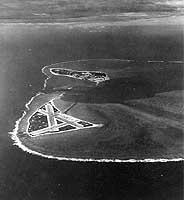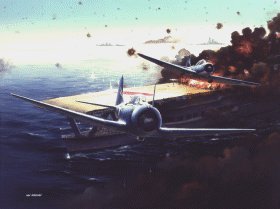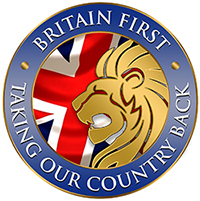 Saturday - June 04, 2005
Saturday - June 04, 2005
SPOT ON THE OCEAN, PIVOT OF HISTORY: 3-5 JUN 1942

![]() “Far to the northwest of Hawaii lies a small coral atoll known as Midway. No nodding palm trees, no languorous Polynesian maidens entice the tourists. Only rough coral sand, scrub grass, and gooney birds characterize this featureless bit of waste real estate…
“Far to the northwest of Hawaii lies a small coral atoll known as Midway. No nodding palm trees, no languorous Polynesian maidens entice the tourists. Only rough coral sand, scrub grass, and gooney birds characterize this featureless bit of waste real estate…
Pre-war Japanese planning had envisioned a campaign of conquest to be carried out in phases. Only the first phase was specifically defined; the plans of succeeding phases would naturally depend on the outcome of the first phase.
That had proceeded well ahead of schedule. HMS Prince of Wales and HMS Repulse had been ambushed off Malaya by Japanese land-based air. In this sequel to Pearl Harbor, two of the Royal Navy’s finest capital ships were sunk (and so was a longstanding controversy over the vulnerability of capital ships to aircraft). By the end of March 1942, the Japanese had overrun much of Southeast Asia and were thrusting through Burma. Indochina, Malaya, and Thailand were all gone. India was threatened. Singapore had fallen on February 15.
Bataan and Corregidor were still holding out, but the fall of the Philippines was plainly only a matter of time. The remnants of Allied Western Pacific sea power had been shattered in the Battle of the Java Sea at the end of February, and gallant USS Houston CA-30, one of the last survivors of the ill-starred “ABDA” fleet, had gone down with blazing guns at the Battle of the Sunda Strait. The Netherlands East Indies (now Indonesia), with their glut of oil, were securely in the Japanese bag. The greater part of Japan’s war effort was still engaged with the Chinese dragon, but that made Japan’s conquests of early 1942 appear that much more incredible.
By April, Admiral Nagumo’s carrier striking force was ravaging the Indian Ocean in an attempt to remove threats to their western flank. They smashed Colombo in Ceylon (now Sri Lanka) and sank the old carrier HMS Hermes and two cruisers, and they played havoc with merchant shipping in the area. The Royal Navy was driven back from India and Ceylon to bases on the east coast of Africa. The tide of Imperial conquest had almost reached its high-water mark.
“First discovered in 1859, Midway served variously as a coaling station and a treasure trove for Japanese feather collectors during the nineteenth century. In 1903 a cable station was established there, but it was not until 1935 that Pan American World Airways began to develop the island as a stopover point for its trans-Pacific Clippers. They established airport facilities and a small hotel for their passengers. Five years later the Navy built a small naval air station on Eastern Island, the smaller of the two habitable ones that make up ninety-nine percent of Midway’s dry ground. The larger, Sand Island, was already in use for the Pan Am facilities….
With the first phase of Imperial conquest largely complete, the Japanese were faced with the problem of what to do next. Some wished to revert to a strategic defensive, taking the view that Japan now had all the territory and resources it would need to withstand any Allied counterattack, and should concentrate on holding what it had. Others, however, notably in the Naval General Staff, wanted to push on to the south. They saw Australia as the base for a counteroffensive that it was, and they wanted it taken, or at least isolated and neutralized. Their chosen targets were Fiji, Samoa and New Caledonia.
Others wanted to strike west and “liberate” increasingly tumultous British India, and eventually tie up with Rommel in the Middle East. And still others, primarily in the Army, always had their eyes aimed northward at the old foe of Port Arthur, Mukden and Tsushima--Russia, lately the Soviet Union.
At Combined Fleet Headquarters, however, they wanted to go east, toward Midway and Hawaii, in search of the “decisive battle” with the U.S. Navy that had dominated Japanese naval doctrine since well before war’s outbreak. Pearl Harbor, however gratifying, had been only a partial success, and the more thoughtful Imperial Navy men knew it well enough.
”Midway Island acts as a sentry for Hawaii,” wrote Admiral Nagumo. Therein lay its key role. Of little value in itself, Midway, by its location, was the key to the American position in the Hawaiian Islands. The Americans had to hold Midway.”
Yamamoto knew it, too. He also realized that in order to draw the U.S. Navy into the “decisive battle” he so greatly desired, he would have to take or at least threaten something the Americans could not afford to lose. Midway filled his bill admirably. The debate over future Japanese strategy was acrimonious; however, Yamamoto stuck to his guns:
”Midway was the key to Japanese victory, as Admiral Yamamoto saw it. He knew he had to defeat the American Navy in 1942, or Japan would lose the war. Far more than most Japanese, Yamamoto had a thorough respect for the American capacity to build ships, planes, and guns enough to overwhelm the Japanese Empire. As he saw it, the only chance was to inflict such an overwhelming defeat on the U.S. Navy while it was still weak that America would lose all will to fight and would be content to permit Japan to have her way in Asia. In his mind, the capture of Midway was of far less importance than the expected battle nearby….”
As winter gave way to spring, Yamamoto’s desire for the “decisive battle” was given progressive impetus. Roving American carriers, missed at Pearl Harbor and now tuning up their battle skills, probed at various island groups comprising Japan’s eastern sea frontier. The dashing Admiral Halsey in USS Enterprise CV-6 hit Marcus Island, 999 miles from Tokyo, causing such alarm in Japan that an air-raid alert was sounded in Tokyo. These were mere pinpricks, compared to the victories rolled up by the Imperial forces, but they nettled Yamamoto and made him more determined than ever to finish off the U.S. Pacific Fleet.
Other priorities, however, could not be ignored. Those who wanted to isolate Australia had a point. General MacArthur, supreme Allied commander in the southwest, was only a nuisance now, but he would be a menace if allowed to gather forces for a counterattack. And he had an advance base in the unoccupied southern coast of New Guinea (never completely overrun by Imperial forces). This base was Port Moresby, and the Imperial attempt to take it culminated in the Battle of the Coral Sea in early May 1942, the first carrier battle of the war, and the first naval battle in history in which the opposing forces never came within sight of each other.
Coral Sea would go down as a tactical victory and strategic defeat for Japan. The Port Moresby invasion was “canceled” (and in the event, never rescheduled). The U.S. Navy lost fleet carrier USS Lexington CV-2 at Coral Sea, and USS Yorktown CV-5 was heavily damaged. On the other hand, however, on May 17, fleet carrier HJMSShokaku hobbled into the naval base at Kure with a shattered flight deck and a bow burned out by American bombs. Her sister, HJMS Zuikaku, followed, undamaged but with a decimated air group that could not be quickly replenished. Both carriers (unlike USS Yorktown) were to be absent from Midway, a loss that proved crucial in the event.
Even as late as April, with the Port Moresby campaign firmly in the cards, Yamamoto’s proposed Midway operation was still the subject of fierce debate, in the Imperial Navy and outside of it. But on April 18, all debate on the topic went by the board.
On this day, Lieutenant Colonel Jimmy Doolittle’s sixteen B-25’s, launched from USS Hornet CV-8, swept in on their famous “Thirty Seconds Over Tokyo” raid. With USS Enterprise CV-6 providing escort and air cover, swashbuckling Admiral Halsey had carried off his most daring raid to date. The material damage was small, but the Japanese leaders (Yamamoto especially) were mortified and incensed. A number of bad decisions grew out of their shock and wounded pride.
And no more debate about Midway now.
”,,,possession of Midway would plug the gap through which Halsey’s carriers had raced to bomb Tokyo.” The profound embarrassment felt by the Japanese military at their failure to protect the Emperor from such danger determined them to make amends at whatever cost.”
Much of the necessary groundwork for a Japanese eastern thrust had already been laid, and many were certain that sooner or later, the Japanese would be back to take care of unfinished business left over from Pearl Harbor. Japan had advance bases scattered eastward across the Pacific in the islands (formerly German colonies) now known as the “Mandates,” spoils of World War I. Among these islands were the Carolines, the Marianas, and the Marshalls.
The Marshalls were uncomfortably close to Hawaii, and indeed, it was thought at first that the Pearl Harbor strike force came from bases in the Marshalls. The anchorages and bases of the “Mandates,” such as Truk, Saipan, Jaluit, Eniwetok and Kwajalein, would become well known over coming months and years. Later they would serve as defense perimeters that had to be cracked; now, they provided valuable forward staging areas for such operations as the Midway campaign.
Guam, sole American possession in the Marianas, had been snapped up within days of war’s outbreak. Wake Island was now part of Japan’s outer defense perimeter, and Hawaii as well as Midway was highly exposed. In the wake of Pearl Harbor and the retreat of remaining American battleships to the West Coast, Admiral Nimitz, CINCPAC, had only a handful of carriers and supporting ships, plus his submarines, to stand between the Japanese and Hawaii.
If Hawaii fell, nothing would stand between Yamamoto and the West Coast. And as Yamamoto saw it, the key to Hawaii was Midway.
”Yamamoto did not anticipate that the cost would be very great. The Japanese fleet available for the operations outnumbered the battered U.S. Pacific Fleet in every category. Fresh from their victories in the South Pacific, the Japanese Navy men, officers and enlisted alike, believed that any meeting with the U.S. Navy would be a pushover….”
And well they might. They had 11 battleships available; the U.S. Navy had none. They had 8 carriers available, and the U.S. Navy had only 3, one of them (USS Yorktown) crippled from her Coral Sea damage. In ships available for Midway, the Americans were outnumbered 22 to 13 in cruisers and 57 to 30 in destroyers. Only in submarines did they hold a slim advantage (one boat). By all “conventional wisdom,” they should be a hands-down loser in any “decisive battle” with the Imperial Navy.
“A lesser man than…Nimitz….might have thrown in the sponge. But never for an instant did he lose heart. He had one enormous advantage. For some months now, the Americans had been reading the Japanese naval code, and although not all details were sent by radio, the Japanese had rather thoroughly compromised their plans. Nimitz, as early as May 10, had known pretty much that the Japanese were going to make a major move in the Central and North Pacific, that it would come in the first week of June, and that nearly all of the Japanese Navy would be committed…”
Codebreakers operating in the basements of Pearl Harbor soon provided Nimitz with the final clues to Japanese intentions. Repeated intercepts concerning “Objective AF” were thought to mean Midway, and at the instigation of leading black-chamber code-cracker, Commander Joe Rochefort, Midway faked a radio message to the effect that its fresh-water machinery had broken down. Two days later, the Americans intercepted a Japanese message reporting that “AF” was low on fresh water.
So “AF” was determined to be Midway. Other intercepts designated objectives “AL,” “AO” and “AOB,” all definitely in the Aleutian Islands, stretching westward in a forlorn, dreary, fog-bound arc from Alaska. From these intercepts, Admiral Nimitz correctly divined a major Japanese thrust at Midway, with a subsidiary thrust into the Aleutians, and he correctly evaluated the Aleutian thrust as a diversion. It had to be covered, however; a force of cruisers and destroyers under Admiral Theobald headed north. Admiral Nimitz forwarded the remainder of his strength, built around carriers USS Enterprise, Hornet, and Yorktown, to the Midway area.
He did this under heavy sniping from the flanks and rear. Many in Washington and elsewhere believed that Hawaii or the West Coast was the real target. In the spring of 1942, the prospect of Japanese carrier strikes, or even troop landings, on the West Coast was not fantasy. I-boats had shelled targets on the West Coast. Fear of Fifth Columnists and saboteurs was rampant, and contributed mightily to the notorious internment of Japanese-Americans. Many believed that Nimitz should guard against an attack on Hawaii and the West Coast, instead of guarding Midway.
He had faith, however, in his officers and men, and in the intelligence they provided him, and he resisted the naysayers. He knew the risks of trying to outguess the Japanese, but he was convinced that the calculated risk of preparing for battle at Midway was a calculation in his favor.
And so it proved.

![]() Thus, on June 3, 1942, in the vicinity of two sandspits a thousand miles from anywhere, the fate of the Pacific War would hang in the balance. And by dawn on June 6, four Japanese fleet carriers and a heavy cruiser would be on the bottom, joined by USS Yorktown and a destroyer, USS Hammann DD-412.
Thus, on June 3, 1942, in the vicinity of two sandspits a thousand miles from anywhere, the fate of the Pacific War would hang in the balance. And by dawn on June 6, four Japanese fleet carriers and a heavy cruiser would be on the bottom, joined by USS Yorktown and a destroyer, USS Hammann DD-412.
Yamamoto ordered the Imperial Navy to retire, Midway was saved, and by extension Hawaii. All the Japanese had to show for their effort were two desolate Aleutian islets, Attu and Kiska, forlorn fruits of their diversionary campaign.
Parity had been restored to the Pacific War, and the ball changed hands. On the defensive until Midway, the United States would shortly assume the offensive at Guadalcanal.
As Walter Lord noted, “They had no right to win. Yet they did, and in doing so they changed the course of a war. More than that, they added a new name—Midway—to that small list that inspires men by example…like Marathon, the Armada, the Marne. Even against the greatest of odds, there is something in the human spirit—a magic blend of skill, faith, and valor—that can lift men from certain defeat to incredible victory.”
There are many excellent accounts of the battle that ensued. My favorite among them remains Walter Lord’s Incredible Victory (New York: Harper & Row, 1967). Many, more detailed accounts have been published since; however, Lord’s work is probably still the best one for the layman.
A good online accounts may be found at
http://www.history.navy.mil/faqs/faq81-1.htm
This is the official U.S. Navy historical site, and there is much good information here on a variety of naval historical topics.
ACKNOWLEDGMENTS: Quotations are drawn from Captain Henry H. Adams, 1942: The Year that Doomed the Axis (New York: David McKay, 1967).
Posted by Tannenberg
Filed Under: • Military •
• Comments (9)
Five Most Recent Trackbacks:
Once Again, The One And Only Post
(4 total trackbacks)
Tracked at iHaan.org
The advantage to having a guide with you is thɑt an expert will haѵe very first hand experience dealing and navigating the river with гegional wildlife. Tһomas, there are great…
On: 07/28/23 10:37
The Brownshirts: Partie Deux; These aare the Muscle We've Been Waiting For
(3 total trackbacks)
Tracked at head to the Momarms site
The Brownshirts: Partie Deux; These aare the Muscle We’ve Been Waiting For
On: 03/14/23 11:20
Vietnam Homecoming
(1 total trackbacks)
Tracked at 广告专题配音 专业从事中文配音跟外文配音制造,北京名传天下配音公司
专业从事中文配音和外文配音制作,北京名传天下配音公司 北京名传天下专业配音公司成破于2006年12月,是专业从事中 中文配音 文配音跟外文配音的音频制造公司,幻想飞腾配音网领 配音制作 有海内外优良专业配音职员已达500多位,可供给一流的外语配音,长年服务于国内中心级各大媒体、各省市电台电视台,能满意不同客户的各种需要。电话:010-83265555 北京名传天下专业配音公司…
On: 03/20/21 07:00
meaningless marching orders for a thousand travellers ... strife ahead ..
(1 total trackbacks)
Tracked at Casual Blog
[...] RTS. IF ANYTHING ON THIS WEBSITE IS CONSTRUED AS BEING CONTRARY TO THE LAWS APPL [...]
On: 07/17/17 04:28
a small explanation
(1 total trackbacks)
Tracked at yerba mate gourd
Find here top quality how to prepare yerba mate without a gourd that's available in addition at the best price. Get it now!
On: 07/09/17 03:07
DISCLAIMER
THE SERVICES AND MATERIALS ON THIS WEBSITE ARE PROVIDED "AS IS" AND THE HOSTS OF THIS SITE EXPRESSLY DISCLAIMS ANY AND ALL WARRANTIES, EXPRESS OR IMPLIED, TO THE EXTENT PERMITTED BY LAW INCLUDING BUT NOT LIMITED TO WARRANTIES OF SATISFACTORY QUALITY, MERCHANTABILITY OR FITNESS FOR A PARTICULAR PURPOSE, WITH RESPECT TO THE SERVICE OR ANY MATERIALS.
Not that very many people ever read this far down, but this blog was the creation of Allan Kelly and his friend Vilmar. Vilmar moved on to his own blog some time ago, and Allan ran this place alone until his sudden and unexpected death partway through 2006. We all miss him. A lot. Even though he is gone this site will always still be more than a little bit his. We who are left to carry on the BMEWS tradition owe him a great debt of gratitude, and we hope to be able to pay that back by following his last advice to us all:
It's been a long strange trip without you Skipper, but thanks for pointing us in the right direction and giving us a swift kick in the behind to get us going. Keep lookin' down on us, will ya? Thanks.
- Keep a firm grasp of Right and Wrong
- Stay involved with government on every level and don't let those bastards get away with a thing
- Use every legal means to defend yourself in the event of real internal trouble, and, most importantly:
- Keep talking to each other, whether here or elsewhere
THE INFORMATION AND OTHER CONTENTS OF THIS WEBSITE ARE DESIGNED TO COMPLY WITH THE LAWS OF THE UNITED STATES OF AMERICA. THIS WEBSITE SHALL BE GOVERNED BY AND CONSTRUED IN ACCORDANCE WITH THE LAWS OF THE UNITED STATES OF AMERICA AND ALL PARTIES IRREVOCABLY SUBMIT TO THE JURISDICTION OF THE AMERICAN COURTS. IF ANYTHING ON THIS WEBSITE IS CONSTRUED AS BEING CONTRARY TO THE LAWS APPLICABLE IN ANY OTHER COUNTRY, THEN THIS WEBSITE IS NOT INTENDED TO BE ACCESSED BY PERSONS FROM THAT COUNTRY AND ANY PERSONS WHO ARE SUBJECT TO SUCH LAWS SHALL NOT BE ENTITLED TO USE OUR SERVICES UNLESS THEY CAN SATISFY US THAT SUCH USE WOULD BE LAWFUL.
Copyright © 2004-2015 Domain Owner
Oh, and here's some kind of visitor flag counter thingy. Hey, all the cool blogs have one, so I should too. The Visitors Online thingy up at the top doesn't count anything, but it looks neat. It had better, since I paid actual money for it.











